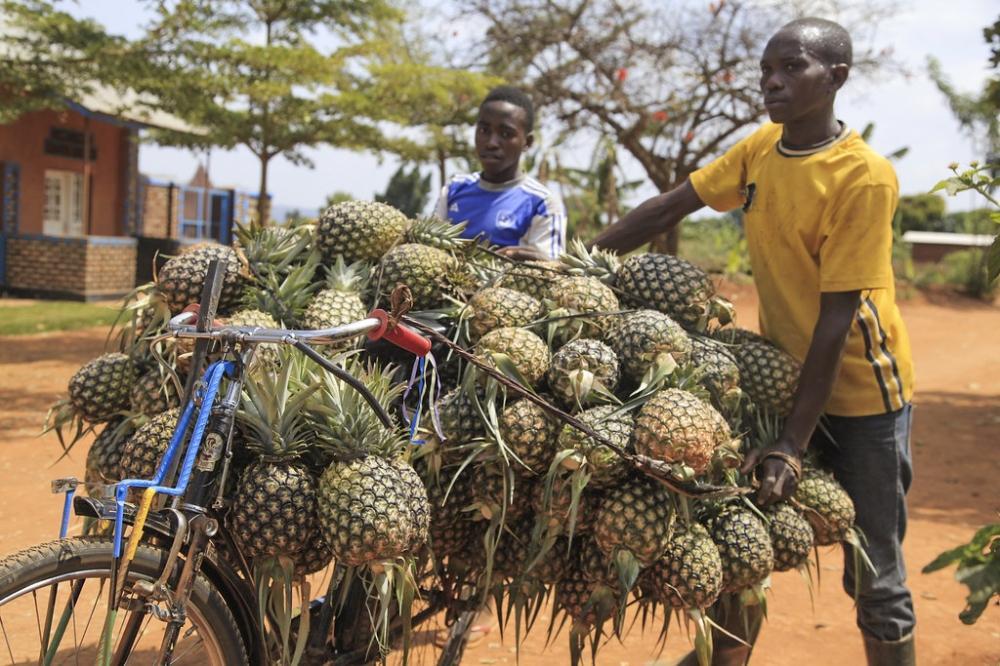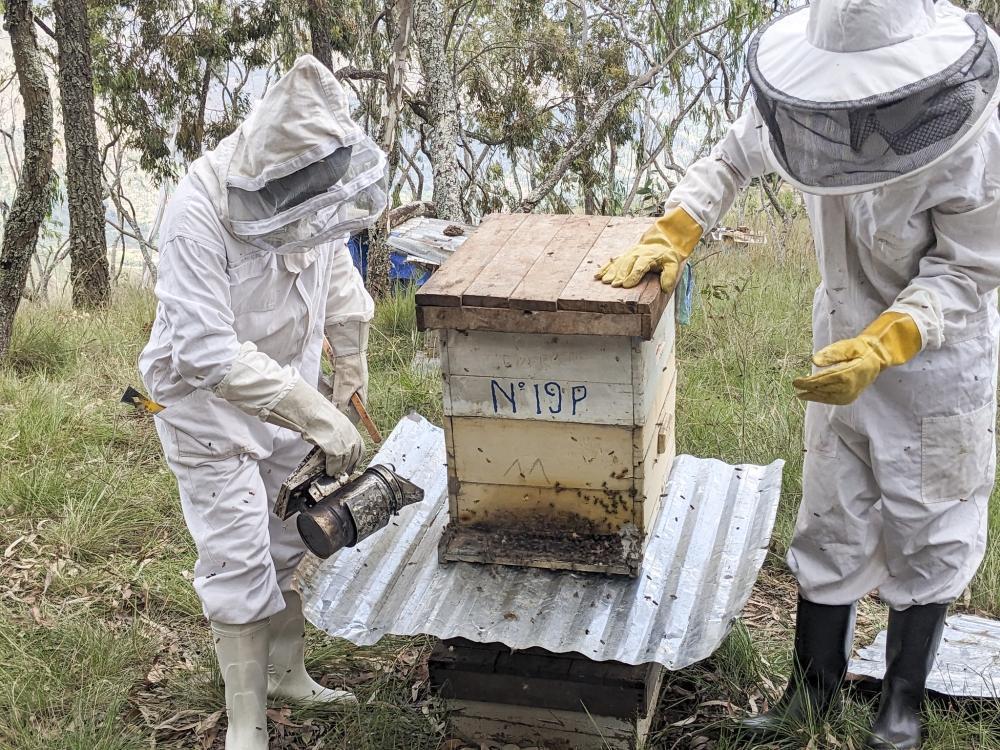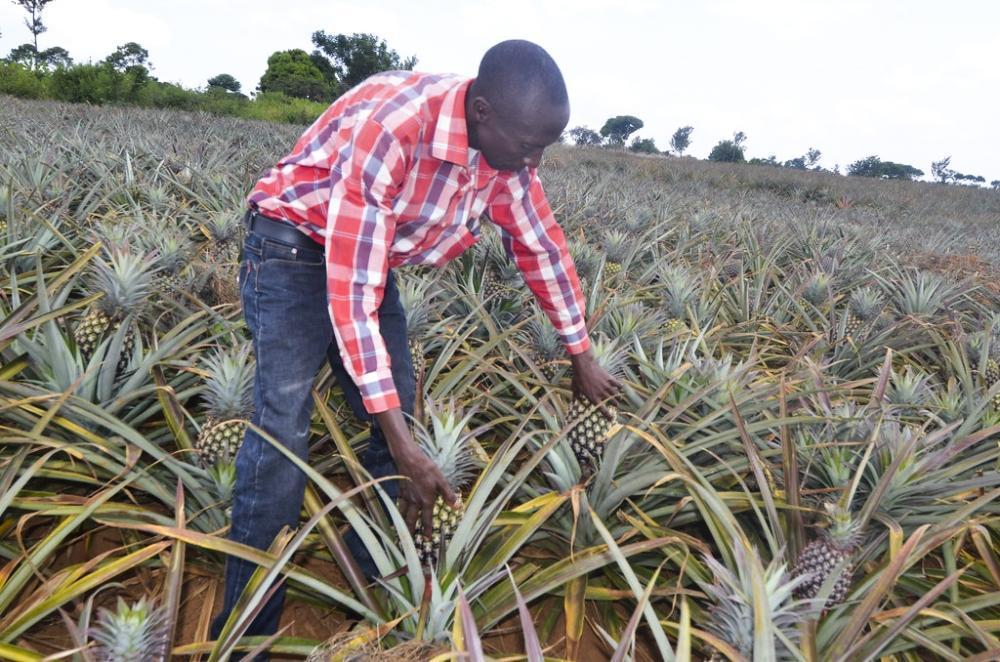Africa-Press – Rwanda. The government has outlined new priorities to increase financial support for farmers, cooperatives, and small and medium-sized enterprises (SMEs) engaged in green agriculture under the Fifth Strategic Plan for Agriculture Transformation (PSTA5).
The plan seeks to strengthen food systems, promote inclusive growth, and build resilience against climate change, according to Alexandre Rutikanga, Chief Technical Advisor at the Ministry of Agriculture and Animal Resources (MINAGRI).
Beekeepers in the farm in Nyamagabe District. Photo by Moise Bahati.
Agriculture contributes about 25 per cent of Rwanda’s GDP and has grown by 5 per cent between 2016 and 2024.
However, loans to farmers remain limited, largely due to the reluctance of financial institutions to invest in the sector. As of June 2025, agriculture, forestry, and fishing accounted for only 2.7 per cent of total bank loans, the lowest among the top ten financed sectors.
Under PSTA5, the government aims to raise agriculture’s share of total bank lending from 6 per cent in 2023/24 to 10 per cent by 2029.
Rutikanga outlined several priority investment areas that are essential for achieving a green and inclusive agricultural transformation.
A pineapple farmer works in his farm in Mugesera Sector in Ngoma District. Photo by Sam Ngendahimana
Expanding irrigation and land rehabilitation
A major focus is irrigation and land rehabilitation. The government aims to expand irrigated land from 70,000 hectares to 132,000 hectares by 2029, with a long-term goal of 500,000–600,000 hectares by 2050 under Vision 2050, he said.
This expansion is expected to improve productivity, enhance food security, and strengthen resilience against climate shocks.
The green finance mechanisms, he noted, include grants, concessional loans, blended finance, and green bonds. The objective is to engage banks, microfinance institutions, insurers, and investors in supporting environmentally sustainable initiatives, he said.
“Investing in education, land rehabilitation, agro-processing, and climate-smart services is essential,” Rutikanga said.
“We are encouraging continued collaboration between government, the financial sector, and private investors to expand access to green finance.”
The government will also invest in agricultural education and capacity building to equip farmers and agribusinesses with modern skills.
“Strengthening agricultural training and research institutions will create an enabling environment for private sector participation throughout the value chain.”
The agro-processing sector remains a top priority
Investment will focus on value addition for crops such as beans, soybeans, and coffee, which can boost export potential, create employment, and increase farmers’ incomes.
Similarly, investments in crop production will target both food and export commodities, including maize, beans, soybeans, avocados, chilli, and passion fruit.
The government aims to diversify export products and promote modern farming practices to ensure productivity and profitability.
Livestock farming
The livestock sector is another focus area, with plans to increase national milk production to 9.5 million litres per day through improved cattle genetics, artificial insemination, and modern breeding technologies.
He said beekeeping is also emerging as a promising sub-sector, driven by growing international demand for Rwandan honey—particularly from China.
The government plans to support beekeepers with finance, training, and market access.
Jean Claude Nsabimana, a beekeeper from Eastern Province, said he needs more finance to increase honey production from 4.5 tonnes to 10 tonnes to meet growing demand.
In addition, fisheries will be expanded to enhance food security and contribute to export diversification, while horticulture—notably avocados, chilli, and passion fruit will benefit from improved logistics and cold-chain systems for international exports.
Climate-smart agriculture
Traditional exports such as coffee and tea remain vital. The government is pursuing new markets in Europe, the Middle East, and the United States.
At the same time, climate-smart agriculture is being promoted to strengthen innovation and resilience through technologies like artificial insemination and embryo transfer.
Rutikanga stressed that women and young people will be key beneficiaries, accounting for 70–90 per cent of targeted financial support under inclusive funding schemes.
“Climate action, finance, and agriculture are inseparable elements of national development,” he said.
“We are promoting partnerships between government and financial institutions to drive green investment through mechanisms such as green bonds, crop insurance, and guarantee schemes.”
Blended finance and private investment
He highlighted blended finance models, combining public and private investment, as a practical approach to mobilise resources.
Patrick Birasa, Country Manager at Cordaid, noted that both grants and loans are supporting farmers to build climate resilience. He cited the Transforming Eastern Province through Adaptation (TREPA) project, which is restoring 60,000 hectares of degraded landscapes, including croplands, forests, and woodlots.
Another initiative, the Promoting Smallholder Agro-Export Competitiveness (PSAC) project, valued at $62.89 million, aims to enhance smallholder export capacity.
“Saving groups are being linked to financial institutions to access loans and expand their businesses,” Birasa said.
“At the Business to Business meeting with impact investors to catalyse SMEs and cooperatives financing in climate resilient value chains, exhibitors showcased innovative financial solutions, while farmers in beekeeping, nursery production, and horticulture presented tangible results from project support.”
Patience Nyiraneza, a farmer from Kayonza District, said she requires more funding to expand agroforestry nurseries, which currently produce 11,500 seedlings, below market demand.
Agricultural insurance as a risk buffer
Access to insurance remains a critical bottleneck in agricultural finance. Jackson Kwikiriza, Executive Director of the Association of Microfinance Institutions in Rwanda (AMIR), said financial institutions often hesitate to lend to farmers due to the sector’s high risk.
“Banks are cautious because many farmers lack insurance. Farmers should take advantage of government subsidies to insure their crops and livestock,” he said.
James Gakuru of Radiant Insurance added that banks and insurers can collaborate to create bundled financial products integrating credit, savings, and insurance.
He made the case for a customer-centred approach, designing products based on actual data about farmers’ production cycles and financial needs.
“For example, a maize farmer could receive a six-month loan combined with crop insurance,” he explained. “If the farmer loses the harvest, the insurance can cover the outstanding balance, reducing default risk for lenders.”
Emmanuel Ngendahayo, a financial expert at Equity Bank, said working with microfinance institutions helps design products that meet local needs, especially for green and climate-smart initiatives.
For More News And Analysis About Rwanda Follow Africa-Press








